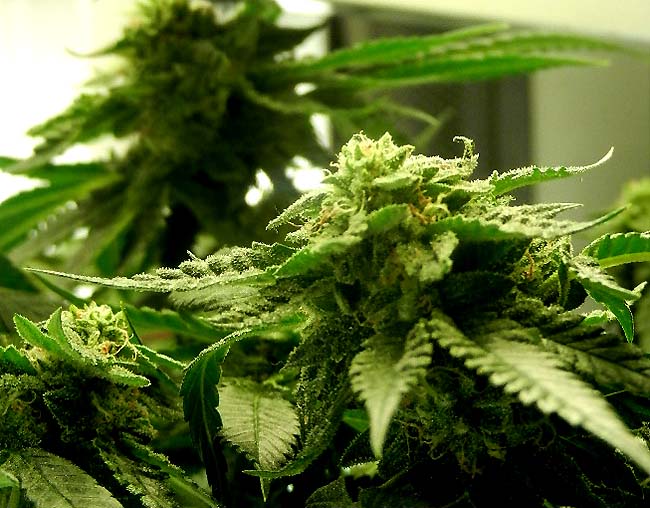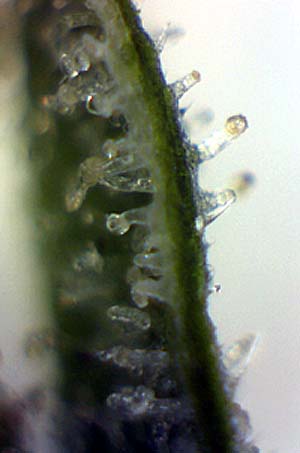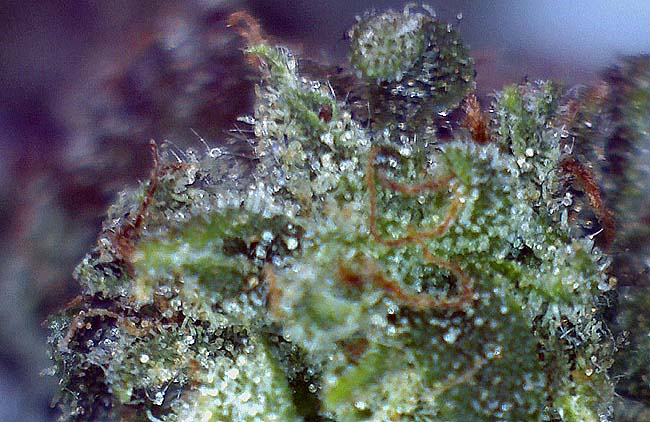It's been 5 days since the plants underwent a low stress technique to limit
height and create a flat topped canopy. Even that technique creates some
stress though and it seemed as if the four week old flowers had stopped growing
with many pistils shriveling up and turning brown. But this has also occurred
in previous grows and may just be a stage related event. This morning there
was evidence of renewed growth so I'm hopeful.
Did find and fix a very minor light leak in the grow room ... one of the
fans has a backlit on/off indicator light which was leaking through the black
tape originally applied to block it. All sources warn of the dire consequences
of the plants receiving light during the 12 hours of darkness - everything
from reverting to the vegetation mode to hermaphroditism. And yet all outdoor
plants receive moonlight during two weeks out of every month without altering
their flowering activities. But just to be safe the fan was re-taped.

4-8: Plants watered today with 1.5 cups of worm cast tea (no molasses) supplemented
with a heavy feeding of FoxFarm's Tiger Bloom (2-8-4) especially formulated
with extra phosphorus to promote flower and bud development. Containers retained
between 186-247 grams (6.5-8.5 ounces) with the fully watered containers
weighing between 552-702 grams.
The original FoxFarms potting soil contained enough nutrients for the first
30 days and these next couple of supplemental feedings will carry the plants
through harvest.
The plants have been fully trained and now only need a gentle restraint to
continue keeping their low profile. It is easier and safer than I thought
it was going to be to unhook the plants for weighing and inspection. Grow
#2 used an overlaid plastic grid to maintain plant height instead but it
wouldn't work here because of the individual containers having to be linked
together under a common
non removable grid.
April 12th: Week 7 (Flowering)

Here we are at week 7 with three more to
go. The terminal colas are averaging 1.25" x 1.0" and are beginning to swell
somewhat. There does not seem to be much new pistil growth though and that
concerns me ... this is the stage of the grow when the flowers should put on most
of their growth. Perhaps due to the more denser nature of indica flowers
the actual pistil growth is concealed beneath the many small single leaves.
Trichome development appears to be on track with many of the smaller top
leaves showing a dusting of resin glands.
The plants were defoliated today
of the remaining multi-lobed fan leaves with stems over 1" long on the theory that the
plants no longer need them for bud development and their maintenance detracts
from the overall energy available. All removed leaves (shake) are being saved and will be sifted for kief following harvest.
With this final defoliation and the recent training all plants are now ideally
spaced and opened up. For this final push the shelf was raised to position
the plants to within 4 inches of the overhead light where they will be monitored
for any heat susceptibility. I also have some 2" tall wooden blocks that
can be put under the containers raising the plants another 2 inches if it
proves that they can tolerate the extra heat.
Plants watered and flushed today with 2 cups of Big Bloom worm cast tea (no
molasses) and a heavy feeding of Tiger Bloom with the plants retaining 196-239
grams of liquid. One more heavy feeding at the end of this week and then nothing but
RO H
2O and molasses for the final 2 weeks which will flush out
any residual fertilizer from the soil forcing the plants to exhaust their
own supplies.
April 19th: Week 8 (Flowering)

The
accidental snapping off of a bud yesterday wasn't a total loss as it did
provide an opportunity to assess the current trichome development captured
in this 150X magnified image from the digital microscope and in the close up below.
Notice that all of the glands are still clear and only a few have fully formed
globular heads on an extended stalk. The flowers will be ready for harvest
when all of the glands have fully formed heads and stalks that have turned
cloudy instead of clear and less than 30 percent show the amber color indicating
that the glands are beginning to deteriorate.
The plants were watered today with their final heavy feeding of 2 cups of
Big Bloom worm cast tea with molasses and Tiger Bloom extra strength fertilizer.
They retained between 168 - 255 grams of nutrients draining freely after the second cup.
The indica strains can handle the larger nutrient load unlike the sativas
from previous grows that thrived at half strength feedings only and tended
towards leaf burn at the higher levels.
The upper leaves are covered every morning now in a fine layer of trichomes looking
and sparkling as if they had been dusted with confectioner's sugar. However an early
assessment indicates that this will be probably the smallest harvest yet
most likely because these indica plants needed to be vegetated for at least
two weeks or possibly more before flipping the lights.
The current plants were flipped at two nodes and only put on 5 more during
the first thirty days known as the stretch whereas the previous sativas were
flipped at 8 inches and ended up with a total of 15 nodes each. Since each
node is a potential site of a flower the more nodes the better goes one train
of thought but others feel that limiting the number of active nodes makes
for larger flowers.
I'm beginning to think an overlooked factor is the size of the root system
which has to support both vertical growth and flowers. It's obvious the larger
the plant the more extensive the root system. Flipping the plants early as
I have been doing limits the size of the plant's subsequent root balls to
what they can achieve in 60 days instead of the usual 90 day growing period
for indoor cannabis.
Switched out four of the side mounted T5HO's to daylight (6500K) spectrum
bulbs to assist in flower growth although my previous use of 2 mixed spectrum bulbs
did not seem to make any noticeable difference. Perhaps 4 is the key.
4-21:

Last night I found another small bud with a stalk snapped from hitting the
hood when being moved. This image was captured with the digital microscope
set at 40X magnification which gives a much better sense of the numbers and
distribution of the resin filled trichomes.
Notice how the pistils have changed
in color from yellow white to brown. They appear dried and withdrawn back
into the calyx which is an indicator of them having reached maturity ... less than one week before harvest is my best guess.
Lowered the plants down a notch today as the previous 2" spacing below the
light put the top of the plants within the hood where the heat is concentrated
and the larger leaves around the tops had completely dried out and were crumbling
to the touch. Now the plants are 4-6" below the overhead light which
appears to be the optimal distance based on prior experience.
4-23:
Plants flushed with 2 cups RO H
2O with molasses only. Even though
it has been 6 days since the last watering the containers only retained between
116 - 166 grams indicating the plants used less water than normal possibly
due to the higher humidity this past week. But it is also possible that the
plants have slowed their growth as they approach maturity as this image of
the trichomes made today shows - all have fully developed globular heads
now and are beginning to fill with resin turning cloudy as they do.
4-24: Due to severe leaf drying plants #'s 2 and 6 were harvested today just
one day short of the 'official' early harvest date. Another check of their
trichomes indicated full development with most turned cloudy but no amber
yet. #2 weighed just 2 grams and #6 weighed 4 grams.
After harvest the two containers were inverted and the root balls checked.
The bottom third of each container was saturated and the root balls were
not extensive extending just a couple of inches below the original grow cube.
That suggests that at some point they each were over watered for their respective
size drowning their roots and stunting subsequent growth.
Clearly these plants need more vegetative time before being flipped into flowering
mode. Two months to harvest is a savings of 30 days per grow but unless a
large number of plants are being grown the smaller return per individual plant
isn't justified by the savings in time and electricity. Since I'm limited
by California law to a maximum of 6 plants my only option is experimenting
with fewer plants and a longer vegetation cycle. In the past the longest
vegetation time was barely two weeks with clones that were two weeks old
to start. The current grow had no additional vegetative time being flipped
as 2 week old clones.
I do have to say though this is one of the more fragrant grows ... I returned
to the coach late this morning when the temps were in the high 70's inside
and the smell was quite noticeable when I opened the outside door. Had these
plants been 18" high like the last grow I would have had to start using a
carbon filter to reduce the odor. Although the grow is perfectly legal
under California law I certainly don't want to attract attention and create
problems for the property managers.
4-25: Today marks a full 8 weeks since the lights
were flipped and the plants are ready for harvest. The only concern is that
they haven't been flushed yet which is a mandatory 'must do' for indoor
cannabis grows. Flushing supposedly removes any excess inorganic chemicals
from the plants through a combination of stopping fertilizer feeding and
leaching the excess out through heavy drenching. This supposedly improves
taste and smokability removing harshness and bitterness and leaving nothing
but a fine grey ash.
Or so it is supposed ... however the last
grow
was harvested in sections over a 42 day period of time with the first section
flushed for 12 days and the final group for a full 42 days. After repeated
samplings I could not detect any difference in taste or smokability between
the two extremes that couldn't be accounted for by their respective length
of flowering. In fact it appeared that what actually determines these
and other factors is the quality and extent of the curing process.
I did find some support for this position among long time growers posting
to the online cannabis boards but the most telling argument perhaps is that
outdoor grown cannabis is not flushed. Common sense (and agricultural law)
though does suggests limiting the use of inorganic chemicals and fertilizers
immediately prior to harvest ... usually the last 7-10 days are water only.
With that being said I decided to go ahead and harvest the remaining plants
today as a test of the no-flush approach. Here is the breakdown by weight:
| Plant #1: |
5 grams |
Plant #4: |
6 grams |
| Plant #2: |
2 grams |
Plant #5: |
6 grams |
| Plant #3: |
11 grams |
Plant #6: |
4 grams |
=======================
Plant
#3 or the mystery plant weighed easily double that of the others but still,
at 11 grams, only half the weight of the average plant in the previous grow.
The root balls of these plants did reach to the bottom of the containers
and the soil was evenly moistened throughout with no bottom saturation.
Based on previous grows the dried weight will be about 20-25% of the wet
weight or a little more than a quarter ounce.
4-27: Plants have dried down to 14 grams which is 41% of the original
34 grams. When they reach 9 grams (26% of the original) they will be trimmed
and the buds will be stripped free of the stems and jarred with a Boveda
62% humidity pack.
4-28: Plants now weigh 12 grams or 35% of their wet weight. Actually they
weighed 14 grams but 2 grams have to be deducted for their 6 labels and the
6 elastic bands securing them to the drying rack. The stems snap easily now
which is the standard indication that they are dry enough for curing though
so they were put in a mason jar, untrimmed, with a Boveda Pack to see if
they can be maintained at 62F. If not the jar lid will be left off to dry
some more.
The plants were trimmed today prior to final curing
even though their weight was down to only 35% of the original because I felt
that they were getting too dry. The RH in the jar was 65% but the heat for
the past few days had the jars up to 85F. The trimmed buds weighed 8 grams
and the total shake combined with the earlier trim weighed another 6 grams
for a total harvest of 14 grams or 1/2 ounce.
The shake was so dry I just rolled the flowers between my palms to remove
it. The buds are beginning to acquire some flavor and smell. Combined with
a bit of the kief I sifted out it made for a relaxed and enjoyable couple
of hours this morning.
6-3: